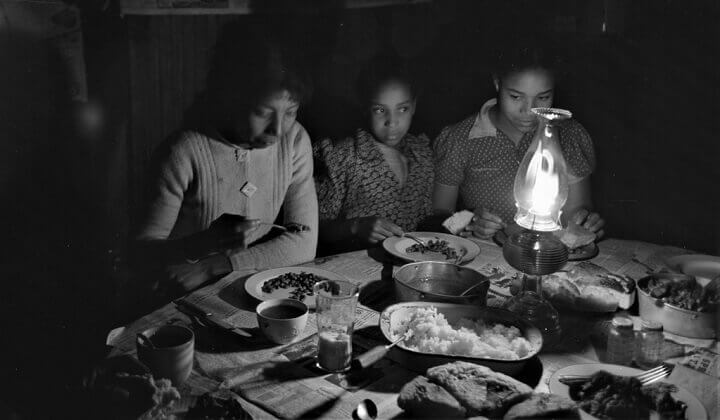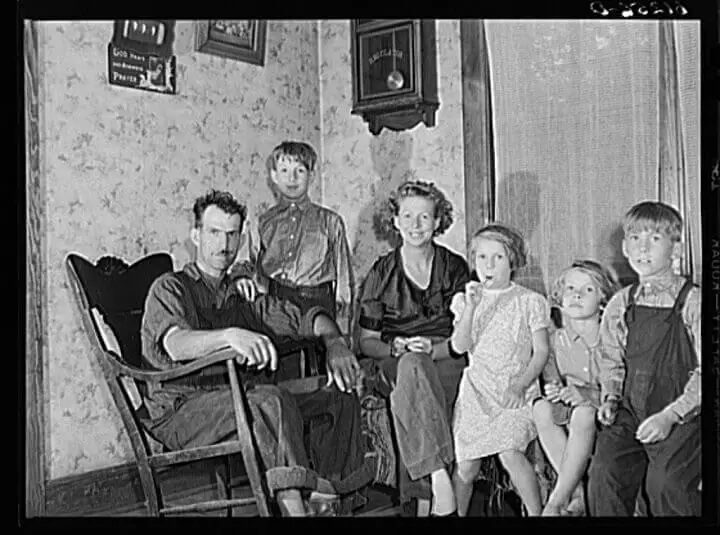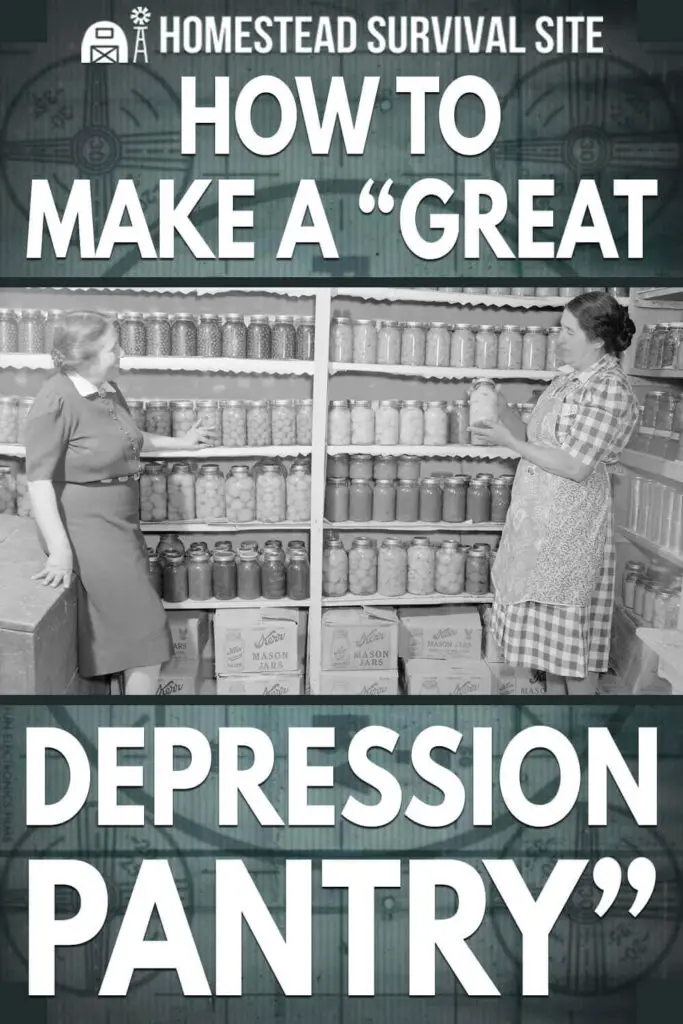Estimated reading time: 8 minutes
The Great Depression was a time in American history where most folks had to live with little food on their shelves. After the notorious stock market crash of 1929, many breadwinners lost their jobs. This meant families now had to get by on just pennies per week, including food and rent.
Families built up their pantries during this time with cheap yet filling foods that could sustain the whole household. We could learn a thing or two from them, and we should in case an even bigger economic depression comes along. If you want to know how to build a Great Depression pantry with some of the same items used in the 1930s, here is how they did it.
Below are all of the items kept in a Great Depression Pantry. They are all long-lasting, hearty, and filling items that can be made into more complex recipes with a little innovation. After all, there was very little food to work with during the Depression.
Want to save this post for later? Click Here to Pin It On Pinterest!
Foods to Stock in Your Great Depression Pantry
For the most successful Depression pantry, here are the best nonperishable foods to store.
Applesauce
With a very long shelf life, applesauce is a great snack or dessert to keep in your pantry. Those during the Depression may have jarred their applesauce using in-season apples and a water bath. If your family had an apple tree, applesauce was a-plenty.
Today, store-bought applesauce is notorious for having a far-off expiration date. It also comes in individually sealed packages for single servings. This leads to much less waste at the end of the day!
Barley
An excellent cereal grain, barley can be used in the same way as oats. Simply heat with some water or milk and you have a porridge that is filling with tons of fiber and vitamins. It is also super cheap for a large bag of dried barley.
You can also use this whole grain in soups or stews. Barley adds a ton of bulk to an otherwise light dish, such as canned vegetable soup.

Canned Fruits and Vegetables
Back in the 30s, fresh fruits and vegetables were expensive and unnecessary. Unless you grew your produce, not many people could afford to buy fresh foods. Canned produce was the way to eat your veggies.
When building a Great Depression-inspired pantry, stock up on your favorites. Buy exactly what you know you will eat. Canned corn, potatoes, peas, carrots, and asparagus are all delicious canned veggies. Peaches, pears, cherries, pineapple, and mandarin oranges are awesome fruity snacks or desserts found in a can.
Canned Meat/Fish
Despite a nationwide market crash, you will need meat for protein in your diet. Canned meat is the best way to feed your family for cheap. It lasts a very long time and can be made into many more complex dishes.
Keep cans of tuna for tuna salad or chicken for chicken soup. Canned meat can be used in the same way as fresh meat. During the Great Depression, folks who were not well-off only enjoyed meats from a can that were preserved, or that were hunted.
Canned Soup
Soup from a can is inexpensive, flavorful, and filling. This rings true today and during the Great Depression. Keep multiple flavors in the pantry for a quick and easy lunch, dinner, or snack.
Coffee
Despite the desperate times, almost all households still kept ground coffee during the Depression. Coffee is essential for lasting energy and boosting morale during rough times.
Dried Beans
Did you know that you can buy large packages of dried beans for just a few bucks? Dried beans are an essential food found in any Great Depression pantry. Beans have tons of fiber, protein, vitamins, and minerals that are imperative for a healthy diet.
Dried beans can make soups, stews, and other dishes much more filling. People during the Great Depression consumed a lot of beans, as they were readily available and affordable at the time.
Dried Pasta/Ramen
Many folks likely already carry a few boxes of pasta in the pantry at a time. For a quick and cheap dinner, many during the Great Depression would boil a pound of pasta and toss it with oil or butter. Many families added odd ingredients to their pasta for bulk, such as hard-boiled eggs or beef jerky.
Ramen is another well-loved nonperishable food that lasts months on a dry shelf. For a salty, satisfying noodle soup, ramen costs only pennies per serving.
Flour
Flour makes many dishes that bring sustenance to a bleak situation. Flour can make bread, hardtack, crackers, and cakes. It can also be used as a thickening agent for soups and stews. Every Great Depression pantry had a type of flour in its arsenal.

Honey
For a sweetener, syrup, or preservative, honey is an essential ingredient for a Great Depression pantry. In addition to recipe use, honey also has medicinal qualities in times of sickness.
Jerky
Packaged or homemade jerky was often enjoyed in Great Depression times. Folks made Jerky Gravy to stretch their ingredients during that time, which looks a lot like sausage gravy today. The jerky gravy was often served with simple homemade biscuits, all of which you will also need flour to make.
Nuts
A healthy and nutritious snack with long lastability is nuts. If possible, folks in the 1930s would try their best to obtain nuts for a filling snack with protein and fiber.
Oats
Oats are not only great for making oatmeal but they can also be processed into delightful flour. Many cakes and bread recipes can be made from oat flour. This fibrous cereal is perfect for a Great Depression shelf, as oats were consumed heavily during the 1930s.
Peanut Butter
Peanut butter is a filling, sweet snack that can be mixed into cookies, hot cereal, or sauces. A large tub is fairly inexpensive and lasts quite a while.
Popcorn
One of the cheapest snacks out there is loose popcorn. This crisp snack can be made over an open fire, if needed, and offers a satisfying crunch. Many families snacked on popcorn during the Great Depression because it was one of the cheapest nibbles out there.
Rice
Dried rice is found in every single food stock since the Great Depression. Large pots of white or brown rice were often consumed as the sole main course during tough times. Rice is one of the more important foods to keep in your pantry for your family to stay well-fed.
Spices
You want to be able to flavor all of the above foods, right? With spices as simple as salt and pepper, you can create highly flavored dishes on a Great Depression budget. More adventurous spices such as dried herbs add dimension to your simple dishes.
Sugar
Sugar will allow for some great baking in your Great Depression pantry. Sugar can provide sweetness to your cakes, cookies, and coffee.
Water
Always keep a surplus of water in your food stock! You can buy fresh water in jugs and keep it for a rainy day. You can also refill your jugs with sink water, but keep in mind this may not always be a viable option during an emergency.
How to Store the Foods in Your Great Depression Pantry
Once you have the foods you need, how do you store them? Here are some tips for optimizing your Great Depression Pantry:
- Keep a detailed list of items and expiration dates. It is very important to stay organized so that you can eat your foods before they expire. You will also never lose track of items when keeping a list.
- Store in a cool, dry area. Moisture, heat, and critters love to forage for easy foods, so keep your stock in a basement, root cellar, or anywhere high off the ground with cool, dry air.
- First in, first out. This means that the foods with the closest expiration dates should be eaten first. This will help avoid any spoilage or food waste.
- Only buy foods you like to eat. Buying just for the sake of a sale doesn’t cut it. If you buy foods you are unsure of liking, they may end up sitting on the shelf and spoiling.
A Great Depression pantry is a pantry that holds excess foods should there be an economic emergency. During the 1930s, few people anticipated having to live off of so little. These are the foods and storing techniques of people who were scared, increasingly desperate, and impoverished.
If you are prepared with a wide range of nonperishable foods, you have a greater chance of beating the uncertain circumstances.
Like this post? Don't Forget to Pin It On Pinterest!











This was an interesting article. But I think you’ve taken quite a few liberties with the truth. First of all, peanut butter was not a common item during the 1930s. It was definitely not a staple that most people kept. Rice was also another item that was not kept that by most Americans. We Americans, at that time, were not great rice eaters. I think you need to do some more in-depth historical investigation into the truth. Before posting these “facts” as reality.